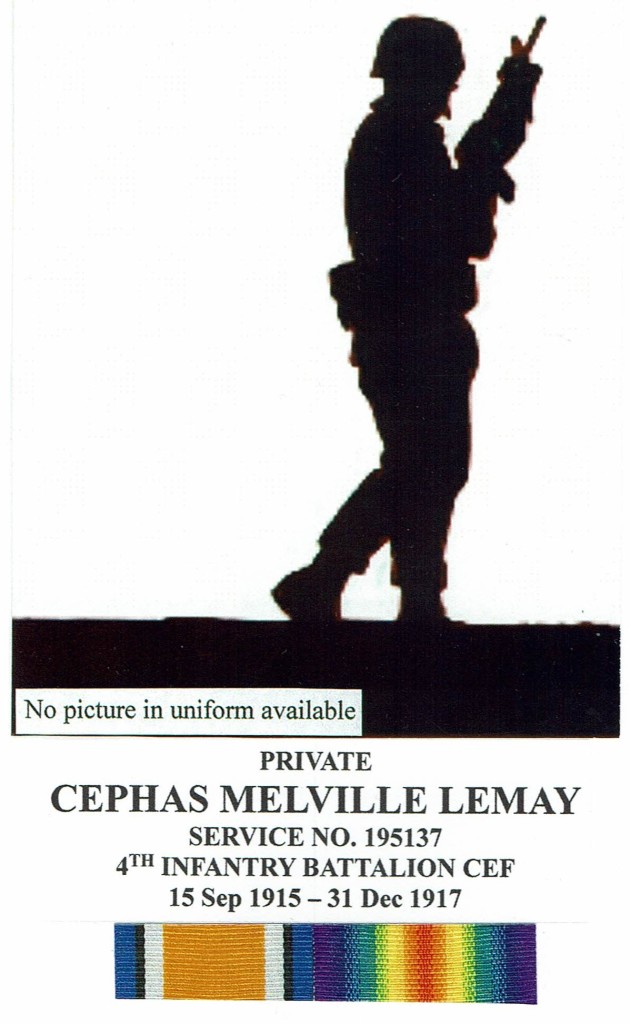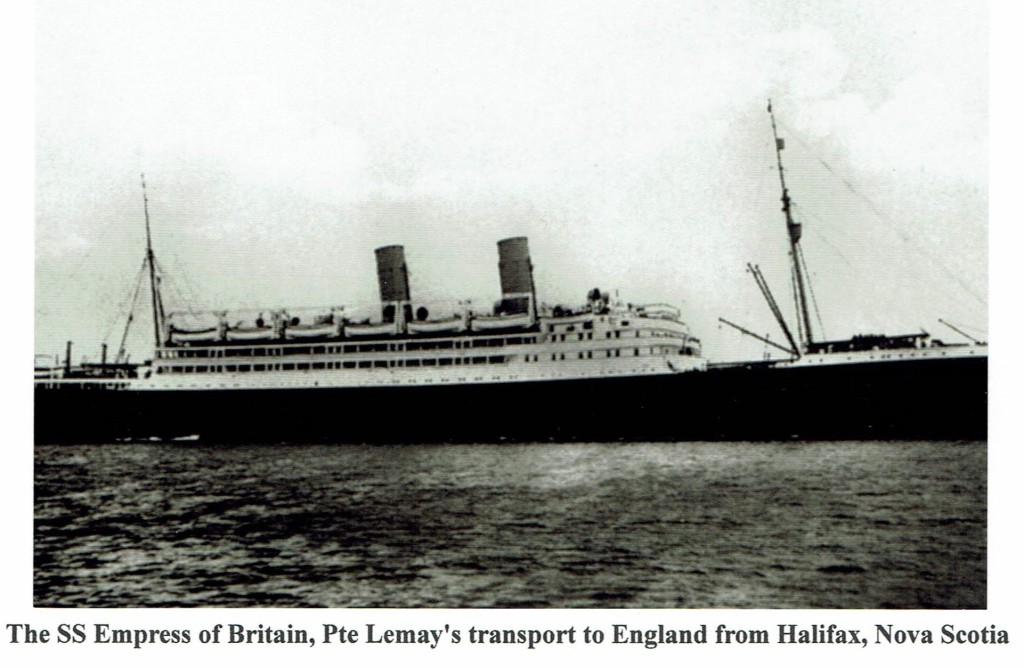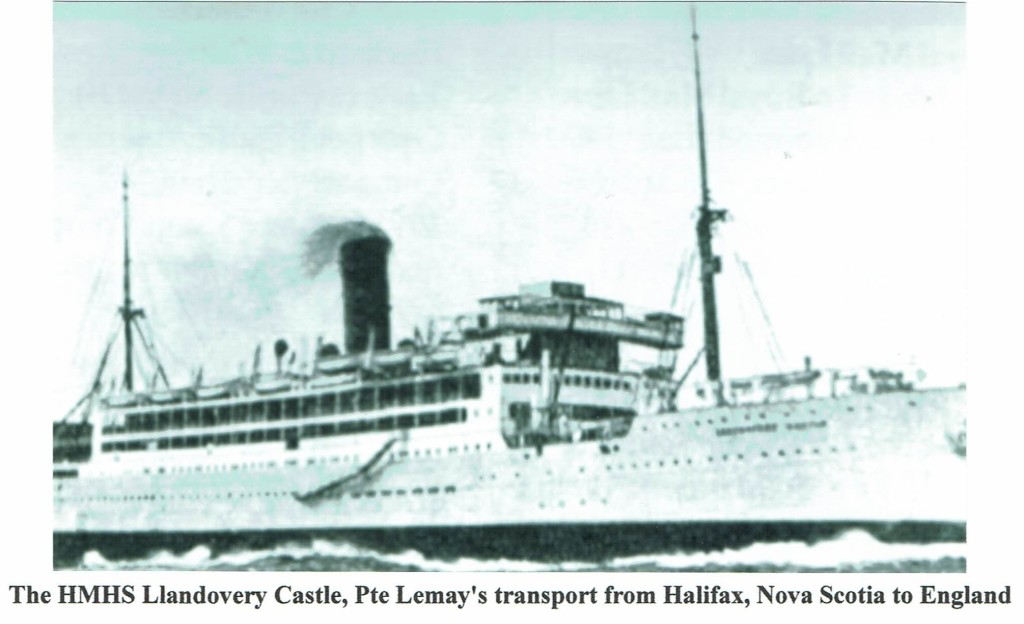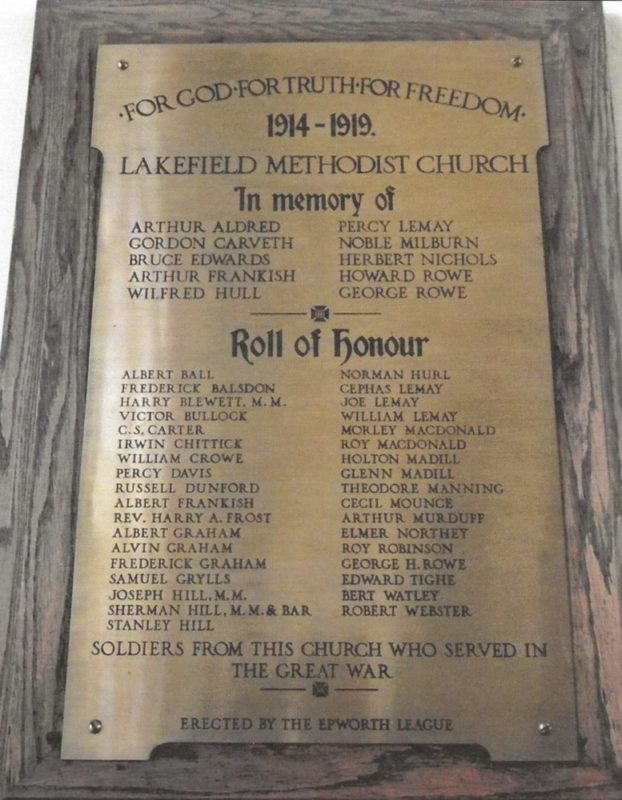
MILITARY HISTORY
Private Cephas Melville Lemay – 195137 — ACTIVE SERVICE (World War I)
On September 15, 1915 Cephas Melville Lemay completed the Attestation Paper for the Canadian Army Canadian Expeditionary Force (CEF) at Peterborough, Ontario. He was 21 years, 1 month old when, as a single man, he enlisted for the duration of the War. Cephas Melville was born in Lakefield, Ontario and gave his birth-date as August 20, 1894. He indicated that ”he did not presently belong to an Active Militia and that he had never served in any Military Force”. There is nothing on his File to indicate where he was educated or to what level. As far as his Trade or Calling is concerned, he lists Canoe Builder. Cephas Melville was 5′ 5” tall, with a 35” chest (expanded). His weight is listed as 135 pounds. He had a dark complexion with brown eyes and brown hair. His Medical Examination was completed September 15, 1915 in Peterborough; he had no medical issues or physical limitations and as such he was deemed fit for Overseas duty with the Canadian Expeditionary Force. His next-of-kin was listed as his father, Mr. Joseph Lemay, of Lakefield, Ontario. Cephas Melville Lemay signed the Oath and Certificate of Attestation on September 15, 1915, in Peterborough, Ontario. The Certificate of Magistrate was signed by the Justice on September 21, 1915. Cephas Melville Lemay was taken-on-strength with the 57th Battalion (Bn), as a Private (Pte) and was assigned Service Number 195137. Private Cephas Lemay was transferred to the 93rd Battalion (Peterborough) when it was authorized and formed up on December 22, 1915.
The 93rd Bn, after training through the winter of 1915 and spring of 1916 at 5 different area Centres, departed by train from Peterborough on May 29, 1916. The 93rd Bn made a short stop at Barriefield Camp located at Kingston, Ontario before moving on the main CEF Training Centre located at Valcartier, Québec to complete Basic Infantry training before being transported overseas, to the UK. The 93rd Bn embarked from Halifax, Nova Scotia on July 15, 1916 aboard the SS Empress of Britain.

Pte Lemay disembarked in Liverpool, England on July 25, 1916. There is no reference in the File, as to where Pte Lemay was stationed from July 25, 1916 until October 5, 1916. During this 3½ month period he would have been on intense training. On October 6, 1916 he was transferred to the 39th Bn stationed at West Sandling, England. On the same day, he was taken-on-strength with the 39th Bn. On October 13, 1916 Pte Lemay was transferred to the 4th Infantry Battalion (Bn). On October 14, 1916 he was taken-on-strength with the 4th Bn, as a reinforcement at the Canadian Base Depot (CBD). Pte Lemay joined the 4th Bn in the Field in France on October 31, 1916.
On November 17, 1916 Pte Lemay was treated at the No 2 Canadian Field Ambulance (CFA) with a gunshot wound to his face and ear. The 4th Infantry Battalion War Diary shows the following entry for November 17th: Battalion in right sub-sector of trenches (Berthonval Sector). ”Quiet morning. Enemy snipers very quiet as usual. Trench Mortar activity in afternoon. Our Artillery and Brigade Machine Guns fired on enemy dumps during the night. Enemy’s Artillery inactive. Patrolled the enemy’s front during the night”.
On November 18th, Pte Lemay was at the No 22 Canadian Casualty Clearing Station (CCCS). November 23, 1916 he was admitted to No 18 General Hospital at Dannes (Ameirs), France. Then on November 28, 1916, he was transferred to No 6 Convalescent Depot at Étaples, France.
On December 1, 1916 Pte Lemay was transferred to No 5 Convalescent Depot at Cayeux, France. On December 6, 1916 he was sent to the CBD. December 12, 1916 Pte Lemay left for the 1st Echelon Battalion, arriving on December 15th.
There are no entries in the File from December 15, 1916 to March 22, 1917. The time could have been spent recovering from the gunshot wound.
On March 22, 1917 Pte Lemay rejoined the 4th Bn which was at rest billets at Estree Cauchie, France undergoing training. In addition to the usual training syllabus; ”the Company Rifle Grenadiers were training with live rifle grenades, the Lewis Machine Gunners were learning to fire their Guns from the hip (a point of interest: the Lewis Machine Guns weighed approximately 30lbs and were about 4 feet long) and the Battalion was practicing advancing in formation”. On March 28, 1917 the 4th Bn moved to Bois les Alieux, France and then on March 29, 1917 to the Front-Line trenches in the Maison Blanche Sector.
April 1, 1917, the 4th Bn moved to a Brigade Support position; it is reported in the War Diary that: ”all ranks are in good spirits and very keen in anticipation of coming operations, in-spite of weather being cool and wet”. On the 6th, the 4th Bn moved to rest billets at Ecoivres. On the 8th, at 2:00 PM, they started their advance to the Brigade Assembly area. After a hot meal, the 4th Bn moved to the forward Assembly area, (Sunken Road Dugouts and trenches in Sector A15), which was complete by 1:30 AM. The time from 1:30 AM and 5:00 AM was spent in checking equipment, having a hot meal, and consuming a ration of rum. At Zero Hour (5:30 AM) on April 9, 1917 Pte Lemay and the 4th Bn began its advance towards Farbus Wood, which was part of the Battle of Vimy Ridge.
The 4th Battalion was part of the 1st Canadian Infantry Brigade, attached to the 1st Canadian Infantry Division.
The War Diary indicates the following for April 9, 1917: ”At Zero Hour – 5:30 AM, the advance began. Not the slightest difficulty was experienced in finding the bridges, gaps in wire, etc. No Man’s Land, between Claudot Group and Paris Group of Craters, was crossed successfully. The Battalion Companies found no difficulty locating themselves in the German trenches. By 9:00 AM, the Unit was at its first objective West of Swischen Stellung. Only 4 casualties were reported up to this point. At 9:55 AM, the Allied Artillery Barrage lifted and the Battalion started its advance on the Blue Objective. The Battalion was played over the Red Line by Bagpipers. The advance continued steadily following the Creeping Barrage, and the Blue Objective was reached on time. Some casualties had occurred during this period. The Artillery Barrage was very effective in keeping the enemy pinned down during the advance. The rear Companies did not deploy into extended order until near the Thelus – Roclincourt Road, while the lead Companies consolidated the Blue Objective. At 12:26 PM, the Barrage lifted and moved forward to the Brown Objective, immediately followed by the advance of the 4th Battalion. The advance continued steadily to the Western German Wire, which was found not to be well cut by the Barrage, as such lanes had to be cut through it before the advance could continue. As the Battalion passed abandoned German Guns, the men wrote the name of the Battalion on the barrels, with pieces of chalk. By 2:00 PM, the lead Companies entered Farbus Wood. Some Germans, who had concealed themselves in the dugouts were either killed or taken prisoner. Patrols pushed forward to beyond the eastern edge of Farbus Wood. Forward Observers, indicated, nothing was seen of the enemy as far as the Railway embankment, in the distance. The German retirement, from this position had been so hasty, that a hot lunch was left ready in the dugouts. It was of course promptly consumed. By 4:00 PM, the 4th Battalion was consolidating its gains”.
A Major Towers, of the 4th Bn, made the following observation of the Unit’s effort during the day: ”The morale of our men could not have been better. All Officers and men seemed to have but one idea in their minds, namely to carry out the work they had been ordered to do. There was no sign of excitement or confusion during the attack”.
There is no reference, in the War Diary, to the total number of casualties the Battalion incurred on this day.
Private Lemay received a gunshot wound to the right knee on April 9, 1917. On April 10, 1917 Pte Lemay was admitted to the No 5 British Red Cross Hospital at Wimereux, in France. On April 12, 1917 he was posted to 1st Central Ontario Regimental Depot (CORD) at Shorncliffe, England. On April 13, 1917 he was taken-on-strength with 1st CORD from the 4th Bn and on the same day he was admitted to the Horton (County of London) War Hospital located on Long Grove Road, Epsom, England. On July 13, 1917 Pte Lemay ”ceases to be shown in Hospital” on transfer to the Canadian Convalescent Depot at Uxbridge, England.
On September 19, 1917 Private Lemay was struck-off-strength from the 1st CORD on embarkation from Liverpool on HMHS Llandovery Castle bound for Canada.

Private Lemay would have disembarked in Halifax around September 29, 1917. His File does show him at the Convalescent Home No 3 District Depot Kingston, Ontario, on September 30, 1917. Pte Lemay was examined at Queens Military Hospital Kingston on November 12, 1917. The findings were: ”Impairment of extension & flexion right knee due to a gunshot wound (GSW), bullet having penetrated joint. Bullet still in ½” atrophy of muscles above & below knee. Walks with a limp. Can walk about 1 mile. Limitation movement right knee impairs usefulness ¼”. The findings: ”impairment permanent, should be discharged”. Private Cephas Melville Lemay was discharged from His Majesty’s Service December 31, 1917.
There is no mention in the File with regards to what Military Medals Private Cephas Melville Lemay was eligible to receive or was awarded. Based on his Military Service, he was awarded the:
British War Medal; and
Victory Medal.
He would have also received the CEF Class “A” War service Badge.
Based on his Military File, Private Cephas Melville Lemay served a total of 2 years, 3 months and 16 days with the Canadian Expeditionary Force: 1 year and 1 month in Canada; 8 months in England; 5 months and 26 days in France plus 20 days travel time from and to Canada.
An excerpt from an article in Maclean’s by Barbara Ameil, September 1996:
The Military is the single calling in the world with job specifications that include a commitment to die for your nation. What could be more honorable.
PERSONAL HISTORY
CEPHAS MELVILLE LEMAY
Cephas Melville Lemay was born August 20, 1894 in Lakefield, Ontario to Joseph Lemay and Martha Helena Jory. He was educated in the Rural Public School System.
Cephas Melville Lemay, 25, married Florence May Carmichael, 25, a dressmaker, in Toronto, York on August 11, 1920.
Early in his teens, Cephas was employed as a tinsmith at a local store, and early in his career, Cephas became a canoe builder.
After the war, Cephas and his family went to live in Toronto. Cephas and Florence had two children Audrey Etta and Elmaire Jean Lemay, who married Kenneth Beavis.
Cephas Melville Lemay died in Toronto on February 9, 1959 and is buried in Lakefield Cemetery.
THE CEPHAS MELVILLE LEMAY FAMILY OF LAKEFIELD
Cephas Melville’s paternal grandparents are Francis Lemay, born about 1794 and Mary Elizabeth Tates, born about 1830. Francis and Mary Elizabeth had seven children: John, born about 1860; Elizabeth, born about 1861; Harriette, born about 1863; Agnes, born about 1865; Francis (Jr), born about 1867, Joseph, born about 1870 and Margaret, born about 1872. His maternal grandparents are James and Emma Snelgrove.
Cephas Melville’s parents, Joseph Lemay, 22 years old and Martha Helena Jory, 26 years old married in Warsaw, Ontario on February 23, 1892. In the early 1900’s, Joseph and Martha lived in the Village of Lakefield where Joseph worked at the Canada Cement plant.
Later the family moved to Smith Township where Joseph took up farming. Joseph and Martha had one child: Cephas Melville, born August 20, 1894 in Lakefield, Ontario.
Cephas Melville Lemay, son of Joseph Lemay, is a first cousin to Percy Melville and his half-brother, William John. He is also a Nephew of John Louis and a grandson of Francis and Mary Elizabeth Lemay.
Cephas Lemay was a member of the Lakefield Methodist church and is included on the Memorial Plaque which honours their members who served in the Armed forced during World War 1. The plaque currently hangs in the sanctuary of the Lakefield United Church 47 Regent Street, Lakefield Ontario.
